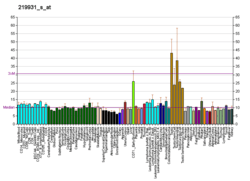Kelch-like protein 12
Kelch-like protein 12 is a protein that in humans is encoded by the KLHL12 gene.[5][6]
Interactions
KLHL12 has been shown to interact with RIT1[7] and CUL3.[7]
gollark: Besides, this computer only has a 240GB SSD, I can't waste space on winDOS.
gollark: And I don't actually want to use Twitch anyway.
gollark: Fine, actually! Most of the software I want to use does work fine.
gollark: I've been looking at `mcdex` but it seems to not be designed for MultiMC much.
gollark: I do use it, though.
References
- GRCh38: Ensembl release 89: ENSG00000117153 - Ensembl, May 2017
- GRCm38: Ensembl release 89: ENSMUSG00000026455 - Ensembl, May 2017
- "Human PubMed Reference:". National Center for Biotechnology Information, U.S. National Library of Medicine.
- "Mouse PubMed Reference:". National Center for Biotechnology Information, U.S. National Library of Medicine.
- Strausberg RL, Feingold EA, Grouse LH, Derge JG, Klausner RD, Collins FS, et al. (December 2002). "Generation and initial analysis of more than 15,000 full-length human and mouse cDNA sequences". Proceedings of the National Academy of Sciences of the United States of America. 99 (26): 16899–903. Bibcode:2002PNAS...9916899M. doi:10.1073/pnas.242603899. PMC 139241. PMID 12477932.
- "Entrez Gene: KLHL12 kelch-like 12 (Drosophila)".
- Rondou P, Haegeman G, Vanhoenacker P, Van Craenenbroeck K (April 2008). "BTB Protein KLHL12 targets the dopamine D4 receptor for ubiquitination by a Cul3-based E3 ligase". The Journal of Biological Chemistry. 283 (17): 11083–96. doi:10.1074/jbc.M708473200. PMC 2431063. PMID 18303015.
Further reading
- Maruyama K, Sugano S (January 1994). "Oligo-capping: a simple method to replace the cap structure of eukaryotic mRNAs with oligoribonucleotides". Gene. 138 (1–2): 171–4. doi:10.1016/0378-1119(94)90802-8. PMID 8125298.
- Suzuki Y, Yoshitomo-Nakagawa K, Maruyama K, Suyama A, Sugano S (October 1997). "Construction and characterization of a full length-enriched and a 5'-end-enriched cDNA library". Gene. 200 (1–2): 149–56. doi:10.1016/S0378-1119(97)00411-3. PMID 9373149.
- Mai A, Jung SK, Yonehara S (October 2004). "hDKIR, a human homologue of the Drosophila kelch protein, involved in a ring-like structure". Experimental Cell Research. 300 (1): 72–83. doi:10.1016/j.yexcr.2004.06.023. PMID 15383316.
- Uchida K, Akita Y, Matsuo K, Fujiwara S, Nakagawa A, Kazaoka Y, et al. (September 2005). "Identification of specific autoantigens in Sjögren's syndrome by SEREX". Immunology. 116 (1): 53–63. doi:10.1111/j.1365-2567.2005.02197.x. PMC 1802401. PMID 16108817.
- Angers S, Thorpe CJ, Biechele TL, Goldenberg SJ, Zheng N, MacCoss MJ, Moon RT (April 2006). "The KLHL12-Cullin-3 ubiquitin ligase negatively regulates the Wnt-beta-catenin pathway by targeting Dishevelled for degradation". Nature Cell Biology. 8 (4): 348–57. doi:10.1038/ncb1381. PMID 16547521.
- Lim J, Hao T, Shaw C, Patel AJ, Szabó G, Rual JF, et al. (May 2006). "A protein-protein interaction network for human inherited ataxias and disorders of Purkinje cell degeneration". Cell. 125 (4): 801–14. doi:10.1016/j.cell.2006.03.032. PMID 16713569.
This article is issued from Wikipedia. The text is licensed under Creative Commons - Attribution - Sharealike. Additional terms may apply for the media files.




